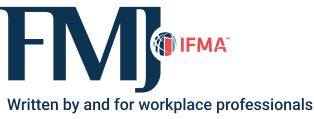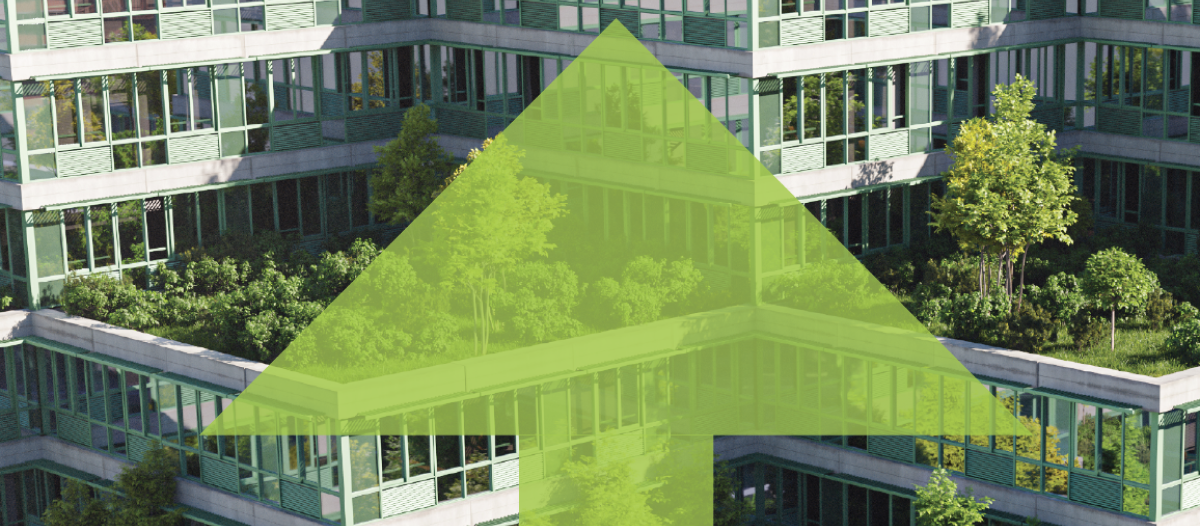Finding Balance
Risks & goals in ventilation

As COVID-19 precautions loosen with the suspension of masking and social distancing requirements indoors in many locations, facility managers may find that the next stage of the pandemic brings new challenges. While COVID-19 cases have lessened, it is unlikely that FMs will ever be able to fully ignore the role buildings play in airborne transmission of infectious diseases. At the same time, it is infeasible to continue to sustain the high levels of strain under which HVAC systems have been placed to mitigate these disease transmission risks. Not only have facilities been burdened with higher operational costs as a result of running equipment beyond as-designed levels, but heightened calls for climate change action have made it increasingly difficult to ignore buildings’ outsized role in generating greenhouse gas emissions (GHG).
Fortunately, this challenge also hints at a path forward. Organizations may find a framework for balancing the triple bottom line of people, planet and profit provides an effective mechanism for guiding decision making for future facility operation. Moreover, FMs are likely to find that sustainable buildings systems can more cost-effectively support the higher outdoor air exchange rates expected during periods of high infectious disease risk in their community. With the use of new tools, FMs can strike an effective operational balance.
The operational costs of COVID-19
For the past two years, HVAC systems operation and controls have been heavily modified to dilute the concentration of possible airborne COVID-19 virus, lowering the probability of infection and providing peace of mind for building occupants. These modifications have proven useful in mitigating virus transmission in many scenarios, but there have been additional consequences as a result of overtaxing these systems.
Increased run times and the costs of heating and cooling requirements for increased outdoor air flow have put a strain on operating costs. One study published in Advances in Applied Energy found HVAC system energy consumption increased by as much as 128 percent during the pandemic. This is due to a combination of the increased outdoor air ratio with extended operation schedules, use of higher efficiency air filters and the added energy demand of auxiliary air cleaning equipment. In time, many organizations may also see a cost impact as a result of the need for sooner-than-expected replacement of overburdened HVAC equipment.
As a case in point, one facility originally designed for 5,500-person occupancy continues to run HVAC systems at the maximum amount of outside air possible, with a three-hour purge each morning before opening, even though fewer than 800 people are within the facility on a typical day. While actions like this made sense at the beginning of the pandemic, when information about airborne SARS-CoV-2 transmission emerged and guidance was sparse, now it is critical to address the tremendous amounts of wasted energy and GHG emissions generated by this level of operation.
As many building operators might have felt, the organization implementing these air purges before and after daily occupancy did not wish to be held responsible for not taking appropriate steps to reduce disease transmission. Yet there is a tradeoff for focusing on infectious disease transmission alone, particularly when indicators suggest a lower risk of infection due to COVID-19, influenza, rhinovirus or other viral risks.
Instead, organizations must identify clear guardrails for delivering the appropriate amount of air as needed while minimizing waste. These guardrails will need to be tailored to control specific environmental risks and conditions, rather than relying on a one-size-fits-all approach to ventilation. The final piece of this puzzle is to communicate these actions and this balance to building owners and occupants who will continue to demand far more visibility into building operations than has been the norm in the past.
 The environmental cost of COVID-19
The environmental cost of COVID-19
In recent years, the operational costs of energy-intensive HVAC units have taken a back seat to concerns about these systems’ carbon emissions. According to the Energy Information Administration, buildings generate nearly 40 percent of annual global CO2 emissions, and organizations that have commitments to lowering their overall GHG emissions will need to take steps to rein in this energy use.
Moreover, many organizations may find themselves required to do so by external drivers that include the expectations of investors, consumers and governments. In the U.S., for example, the White House’s Clean Air in Buildings Challenge, and the Securities and Exchange Commission’s proposed rule requiring companies to include climate-related disclosures in their registration reporting statements. State and local regulations are also increasingly pushing for change. To date, 24 states, as well as the District of Columbia, have adopted GHG reduction targets. More than 180 cities have pledged their commitment to transition their communities to 100 percent clean energy by 2050.
In addition to the sustainability impact of operating HVAC systems more intensively, COVID-19 has left another environmental impact. Building occupants have now had two years of experience that higher rates of outdoor air lead to a healthy, comfortable indoor environment. There is an increased awareness that building operation can have a distinct impact on health.
This awareness of the need for healthy indoor environments is exacerbated by the many occupants now returning to traditional work environments who are experiencing anxiety and stress associated with resuming activities in the physical proximity of individuals beyond their family and circle of close friends. Heightened stress is a well-known risk factor for lower tolerance to normal fluctuations common to the indoor environment such as temperature, drafts, odors, vibration and noise. In other words, building occupants will be more sensitive to the slightest changes in their environment, and are more likely to associate that with a “sick” building.
While ventilation standards and building codes have long been designed to create conditions that are not damaging to one’s health, the wake of the pandemic is revealing an expectation for indoor air conditions that promote good health. Future codes may head in this direction, but it will take time to establish and implement them in new buildings under design and retrofit for existing buildings. For now, it will be up to FMs to take action to ensure more comfortable environments, potentially at the risk of incurring higher operating costs and GHG emissions.
Five pillars for evaluating performance
These new expectations around building operation and performance will require FMs to look beyond existing codes for strategies to meet the demands being placed on their buildings. To assess building performance going more effectively forward, FMs should evaluate these five pillars in terms of how each impacts the triple bottom line of people, planet and profit:
-
1. Health and safety: Do ventilation, air cleaning and space cleaning support building occupant well-being?
-
2. Comfort: Are building occupants satisfied in terms of thermal comfort, including temperature and humidity levels, as well as noise levels, vibration, lighting and glare?
-
3. Sustainability: This requires FMs to address strategies for reprioritizing commitments to reduce energy usage and their organization’s overall carbon footprint.
-
4. How energy is generated: Today this may mean partnering with sustainably focused utility services to reduce GHG emissions; but in the future, it may mean evaluating more sustainable on-site sources of energy generation.
-
5. Increased evidence and transparency: Building trust among building occupants and confidence in facility health and safety will become a larger part of the FM’s world. Strategies may range from public kiosks displaying indoor air quality (IAQ) real-time metrics and quarterly Healthy Building Updates, to inclusion of IAQ updates in environmental, social and governance disclosure statements and more regular communications that convey specifics around measured IAQ.
The key is that this must be an ongoing commitment. FMs and building owners that do not take steps to proactively control this message will find that the narrative will be dictated by external organizations. The NYC Buildings’ Energy Grades system — in which buildings are graded on energy performance — is an example of what may be in store for assessing healthy indoor air.
Plan for a future state
As FMs move toward achieving a better balance of operational priorities, it is likely many will begin by identifying a range of short-term, rapid-payback solutions. One strategy for ensuring immediate results is to have a third party perform a building recommissioning process. Recommissioning an existing building is meant to verify the performance of HVAC systems to ensure these energy-intensive systems continue to meet as-designed performance and energy efficiency standards. Through actions taken as a result of recommissioning, organizations see an average payback of 1.7 years through reduced energy costs. More recently, FMs are pursuing a pandemic building commissioning process that takes a more strategic, documented approach to ensuring building systems operate both efficiently and safely. This will prove a useful tool for meeting triple bottom line goals.
In the long term, FMs will find they must develop a strategy for delivering the necessary amount of clean air at the appropriate time to specific spaces. That “necessary amount” will depend upon how many people are present, what is taking place in that space, and how effectively that air is distributed as well as the level of community spread of infectious disease.
The first step will be for FMs to establish guidelines around what constitutes an appropriate amount of clean air and to ensure systems are able to ramp up and down to deliver enhanced rates of ventilation when conditions call for it.
The next step will be establishing a planning system for managing cycles of increased infectious risks. There will be instances when cases of COVID-19 or other respiratory diseases rise above a certain threshold due to seasonal patterns of communicable respiratory illness and other factors. FMs must identify markers to watch and monitor them regularly. Early warning signs might include rates of local disease incidence or elevated pathogen presence in wastewater or might require IAQ monitoring within the building itself. Many FMs may find it useful to install sentinel systems that monitor ventilation conditions and ensure that provisions for increasing ventilation, air cleaning and personal health protection are appropriate given the potential for communicable respiratory disease transmission.
This attention to infectious risks will require that FMs remain in a state of preparedness. However, with appropriate planning, FMs can easily put systems in place that indicate when it is time to launch an immediate, short-term response to an infectious outbreak or, if needed, a long-term response with a clearly marked turning point for recovery.
On the sustainability side, FMs may find it helpful to take a broader look at factors beyond the realm of their control that impact the five pillars of building performance. For example, managers of large portfolios should become conversant with the renewable or GHG status of the electricity delivered to their buildings. Even though the use of clean energy may be beyond their control, laying as it may in the hands of their utilities, this understanding can pave the way for movement toward options that can better support a sustainable future state.
A greening of the electricity grid is underway, which will help some portfolios more easily achieve sustainability goals. In 2020, renewable energy sources including wind, hydroelectric, solar, biomass and geothermal energy accounted for approximately 21 percent of all electricity generated in the U.S., achieving a record 834 billion kilowatt hours (kWh) of electricity, according to the U.S. Energy Information Administration. While implementation of renewable and nuclear energy is uneven geographically at present, meaning this trend will benefit some properties more than others for the time being, the continuing focus on renewable energy may change sustainability data in regions over time.
This understanding of big-picture sustainability needs can also support goal setting for achieving longer-term, higher ROI solutions. This may mean movement toward the electrification of selected equipment currently powered by natural gas, oil or other fossil fuels. Electrification is the first step toward utilization of renewable-driven power sources. Longer-term solutions may include adoption of on-site power generation through solutions ranging from rooftop solar arrays or geothermal systems to air-water energy recovery systems.
Perhaps the most critical future state to consider, however, is the visibility into building operations that will be more necessary going forward. Building operations have long been invisible to building occupants and financial decision makers. Going forward, it will be critical to present a narrative around how building operation impacts occupant health, comfort and productivity. Similarly, it will be important that FMs are transparent and forward focused in financial and strategic conversations that will guide future investments. Conversations taking place today around the need to balance infection risks with climate change goals will set the stage for tomorrow’s investments in a healthy, sustainable future.

John McCarthy, Sc.D., C.I.H. has written more than 70 technical papers and book chapters and co-edited the “Indoor Air Quality Handbook” (McGraw-Hill 2000), a comprehensive reference for building owners and managers regarding indoor environmental concerns. He is the founder and CEO of Environmental Health & Engineering, Inc.

David MacIntosh, Sc.D., C.I.H., DABT is adjunct associate professor of Environmental Health at the Harvard School of Public Health. As chief science officer of Environmental Health & Engineering, Inc., he and his team design information management systems, analyze complex data sets, develop predictive models, and provide data visualization tools to EH&E’s clients and staff.

David Shore is a frequent speaker and lecturer on workplace and home safety and sustainability. A former director of safety and security for a hospital system, he helps hospitals and health care systems structure programs to minimize liability, maximize resources and improve patient outcomes.
References
COVID-19 Impact on Operation and Energy Consumption of Heating, Ventilation and Air-Conditioning (HVAC) Systems, sciencedirect.com/science/article/pii/S2666792421000329 Aug. 2021
“EPA Announces the “Clean Air in Buildings Challenge” to Help Building Owners and Operators Improve Indoor Air Quality and Protect Public Health.” EPA, March 17, 2022, epa.gov/newsreleases/epa-announces-clean-air-buildings-challenge-help-building-owners-and-operators-improve
“State Climate Policy Maps.” Center for Climate and Energy Solutions, c2es.org/content/state-climate-policy/
“Check Out Where We Are Ready for 100%.” Sierra Club, sierraclub.org/climate-and-energy/map
“Workplace Stress-General.” Canadian Centre for Occupational Health and Safety, ccohs.ca/oshanswers/psychosocial/stress.html
ccohs.ca/oshanswers/psychosocial/stress.html
“Energy Grades.” New York City Buildings, www1.nyc.gov/site/buildings/property-or-business-owner/energy-grades.page
eheinc.com/blog/pandemic-building-commissioning-a-case-specific-strategy-for-reducing-infectious-risks/
Read more on Sustainability and Operations & Maintenance or related topics Building Systems , Operations and Occupant Health
Explore All FMJ Topics









